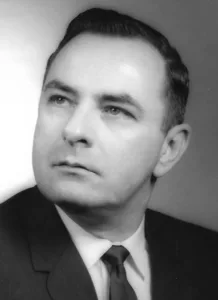Testimony of Raymond P. Woods
D-Day veteran
Born on February 11, 1923, in Bridgeport, Connecticut, Raymond P. Woods was a US Navy sailor aboard the USS O’Brien, where he served as a radar operator, enabling him to monitor radio communications. This destroyer was part of Task Force O, which escorted warships to Omaha Beach; on D-Day, it came as close as possible to the beach to provide fire support to the struggling American soldiers.
A survivor of the war, he passed away on June 26, 2021.
“We reached the waiting position between 8:30 and 9:00 on D-Day. We were about 4 kilometers off Omaha Beach. From this position, we witnessed the complete slaughter of successive assault waves. Bodies floated all along the shore. Landing craft were hit by direct fire, while others circled in place, waiting to disembark the soldiers.
Around 9:00, our coxswain, W. W. Outerbridge, took the initiative to approach as close as possible to the beach toward the cliffs of Pointe du Hoc. At 500 meters from the shore, the captain ordered the destroyer to position parallel to the beach and opened fire with our six 130mm guns toward the German battery located at the top of the plateau.
I later learned that two other destroyers had performed the same maneuver off Omaha Beach without receiving orders. Moments after the first salvo was fired, the radio crackled: it was our men, the Rangers climbing the cliffs of Le Hoc, who had reached the summit but were being stared at by their opponents. The helmsman answered over the radio: “Did we hit you?” The reply came a few moments later: “No, but raise your fire a little.”
We then adjusted the direction of our fire and, after advancing towards the shore, another shot was fired towards the top of the cliff. We detected German soldiers running towards a building behind Pointe du Hoc. The captain waited until the soldiers reached the building to destroy it, which we did in a single salvo.
During the afternoon of D-Day, the situation gradually calmed down for the USS O’Brien. We patrolled along the beach until around 1:00 a.m. I was at my post as an anti-aircraft radar operator when I detected A contact about 100 miles away. Because of the distance, I thought it was the entire German air force, but upon closer inspection, I could see that the radar echoes were fading. Remembering my classes in Virginia Beach, I assumed the Germans were using decoys by dropping aluminum foil. I couldn’t estimate the number of aircraft approaching. It turned out to be just one German Junker bomber.
The orders given to all warships were not to open fire. I then heard two explosions, and the O’Brien began to shake. I called the bridge and asked them what we were firing at. To which I was told, “Firing?” Well, no, we got hit!” Although it’s hard to believe, the following night was identical, the same explosion was felt. A German Junker bomber had dropped a bomb weighing over 100 kg on the starboard side of the O’Brien. The ship tilted to the right at a 45-degree angle before returning to its normal tilt. I didn’t need to call the bridge this time; I understood that we had been hit again.
For years, I could never understand why, of all the ships in front of Omaha Beach, the USS O’Brien was singled out and bombed two nights in a row, probably by the same German aircraft. A few years later, I was talking with Lonas “Lonnie” Frey, who manned a 20 mm anti-aircraft gun aboard the O’Brien. He was from a town near Ottawa: he lived Pandora and I met again at the Ottawa VFW Post 9142 membership reunion. I asked him, “Were there any light sources or how do we explain that we were targeted?” He replied that the German bomber had dropped flares that completely illuminated the surroundings as if it were daylight. The O’Brien, a 2,200-ton destroyer, looked like a cruiser to the Germans and was a prime target. I thought that a light gave away the destroyer’s position during air attacks, but this put an end to my great anxiety during the entire Second World War.”
Raymond P. Woods

